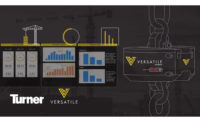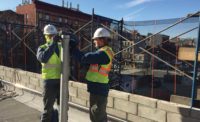Heat stress is a persistent problem on construction sites during the summer months. Workers tend to push themselves to keep working even as they begin to show signs of heat exhaustion, and safety can suffer as a result.
So Ryan Smith, regional safety manager with Kansas-City, Mo.-based contractor Garney Construction, was searching for a better way to keep his teams safe when he came across the Kenzen wearable biometric sensor.
“We’re using it to monitor workers for an immediate health impact,” he says. “[The sensor] will warn us before they reach the level of heat exhaustion.”
Manufactured by Kenzen, a New York City-based technology startup, the sensor straps to the forearm and wirelessly monitors several key health indicators, including heart rate, core body temperature and skin temperature. Using proprietary algorithms, the sensor platform can identify when the wearer is beginning to show signs of heat exhaustion or other heat-related illnesses.
It can then send out alerts to both the user and any nearby safety manager so the worker can take a break or rehydrate.
The battery-powered sensor has a charge that can last for a few days, and users only have to fill out a brief health survey in a mobile app before they begin using it. Data collected by the sensor pairs over low-energy Bluetooth to the wearer’s iPhone, where it is automatically uploaded to Kenzen’s cloud platform. Due to federal privacy law, Kenzen only shows individual health data to the user, but a safety manager can receive general alerts if someone is nearing heat exhaustion.
Planning Work Breaks
Anonymized, aggregate data for work crews can also be used by project managers to plan breaks in work schedules.
“All the data is in the dashboards, where you can break it down based on region, state or work site,” says Smith. “It’s all compiled together to show where those temperatures are going up and down, so we could make a determination like: everyone on a crew is peaking at 3:30pm, so maybe we should take a few minutes off for a break.”
Kenzen began work on the device in 2015, and after years of development and successful fundraising rounds it is now moving into the commercialization phase of the product. Originally developed with sports medicine in mind, the company soon shifted toward industrial applications, such as oil and gas, mining and construction, says Heidi Lehmann, Kenzen chief commercial officer.
“We got started with the ability to predict core body temperature and heat-related injuries, which are typically underreported in industrial settings,” she says. “Heat injuries are 100% preventable, but they have to be caught early.”
The company partnered with Garney this past summer on a dozen jobsites across the country in a range of climates. The results reflect some of the lesser-understood dangers of heat-related illness in construction.
Working to install water pipe in the hot Florida sun, Garney project superintendent Zack Trombley is acutely aware of the health of his crew. “I’ve had this crew laying pipe together for six years,” he says, but having them wear the sensors while working on water projects across the state revealed that some of his team were pushing themselves a bit too hard.
Trombley's crew would tell him that they were good to keep working through the shift on hot, humid days, but he couldn’t ignore alerts coming in from Kenzen saying some were showing signs of heat-related fatigue. “[The workers] thought they knew what their cutoff points were to have to take a break, but we found out those cutoffs were a lot lower,” he says.
While some more experienced workers were reluctant to slow down just based on the alerts, initial skepticism gave way to general acceptance of just another safety measure. “We’re an employee-owned company, so we have a bit of a different mindset on safety. But we also don’t want anyone to get hurt from a personal standpoint: most of our crews are moving around and living together their entire careers,” explains Trombley.
Extra Insight For Contractor
Smith says that the Kenzen sensors have also given Garney a bit more insight into its overall construction practices, including how best to work in specific climates.
Earlier this summer, Smith deployed the wearable sensors on a crew working on water plant expansion in Fort Collins, Colo., where the mornings start off chilly but it can get quite hot by midday. Workers who were bundled up at daybreak tended to shed multiple layers as the day wears on.
“In that Colorado project, [the sensors] showed us workers were overheating earlier in the morning than we would have thought. With how hard they were working, we now figure that by 8 a.m. or 9 a.m. they need to strip off some layers or they’ll get overheated in the next 30 minutes.”
While individual biometric data is protected within Kenzen’s cloud platform, the ability to sift work crews by location, trade or even whether they were indoors or outdoors is useful for planning future work, says Smith. The initial pilot effort saw rolling trials of the Kenzen devices with a few hundred Garney workers on a dozen jobsites across the country, but Smith says he is ready for a broader rollout of the wearable sensors.
He adds that all of the testing of Kenzen's sensors was done on Garney’s self-perform projects, and it will take education and negotiation before he begins recommending them for subcontractors.
Kenzen is also planning to expand the capabilities of its sensor. While heat-related illnesses have been the focus, Lehmann says Kenzen is looking into new functionality that will let the platform predict general fatigue as well, and even eventually cold and frost-related illnesses. An Android version of the app is also in development.
Officially, Kenzen does not consider the sensor appropriate for COVID-19-related temperature checks, but Lehmann says the biometric history of an individual can eventually be used to predict when they are showing early signs of a fever or other illness. She adds that the company is not planning to add any GPS or location-tracking functionality to the device, which could create privacy concers.
“We really designed this product with the worker in mind, which is why they’re the only one seeing the data for the individual,” she explains. “It’s about keeping workers healthy and protected.”








Post a comment to this article
Report Abusive Comment